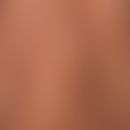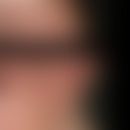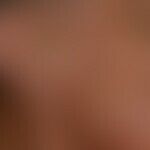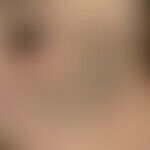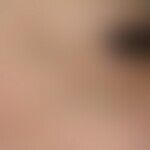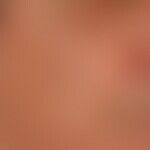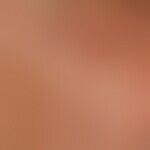Synonym(s)
HistoryThis section has been translated automatically.
DefinitionThis section has been translated automatically.
Solar (possibly combined with senile) atrophy, marked, nodular actinic elastosis with grouped, non-inflammatory, black, expressible comedones and yellowish follicular cysts.
You might also be interested in
EtiopathogenesisThis section has been translated automatically.
Pathogenetically, the localization at chronic light-exposed, mostly hyperpigmented skin areas indicates chronic actinic damage of the cutaneous connective tissue. The resulting loss of elasticity of the connective tissue leads to horn retention in the follicles at the exposed sites (zygomatic bone), to multiple open, black stained, actinic comedones. The follicles are widened by the horn retention. In addition to open comedones, closed epithelial cysts can also be found in advanced clinical pictures. This results in a mixed picture of actinic elastosis, grouped (non-inflammatory) black comedones and deep-seated epithelial cysts.
ManifestationThis section has been translated automatically.
Occurs mainly in men over 50 years of age and is more frequent in cases of nicotine abuse.
LocalizationThis section has been translated automatically.
ClinicThis section has been translated automatically.
Areal, thickened, yellowish, but mostly distinctly brownish, hyperpigmented, wrinkled (elastotic) skin over the zygomatic arches, in the lateral periorbital and temporal region as well as on the nose (so-called lemon skin) and in the neck(cutis rhomboidalis nuchae).
Single, but mostly grouped, non-inflammatory comedones, with black horny plugs in strongly dilated follicular openings (open comedones) as well as larger whitish-yellowish follicular cysts filled with crumbly-greasy masses (closed comedones). In the zygomatic region, sometimes marked hypertrichosis.
Rarely, ectopic localization is possible (so-called actinic comedone plaque on the forearm).
Frequent combination with cutaneous precancerous lesions or carcinoma formation. Rarely, the clinical picture is an indication of an underlying porphyria cutanea tarda.
HistologyThis section has been translated automatically.
Severe areal or nodular elastosis of the upper and middle dermis, completely replacing the normal texture of the dermis; expanded horny follicles with hair segments, atrophy of the follicular wall and sebaceous glands. Frequent melanin deposits in the superficial horny lamellae.
Differential diagnosisThis section has been translated automatically.
Porphyria cutanea tarda (uro- and coproporphyrins); chronic terminal renal failure (dialysis patients). Strictly speaking, these are not differential diagnoses, but an identical process initiated by an underlying disease state.
TherapyThis section has been translated automatically.
LiteratureThis section has been translated automatically.
- Breit S et al (2003) Favre-Racouchot-like disease after radiation therapy. J Am Acad Dermatol 49: 117-119
- Favre M (1932) Sur une affection kystique des appareils pilo-sébacés localisée à certaines régions de la face. Bull Soc Franc Derm Syph (Lyon) 39: 93-96
- Favre M, Racouchot J (1951) L'élastéidose cutanée nodulaire à kystes et à comédons. Ann Derm Syph 78: 681-702
- Lewis KG et al (2004) Acquired disorders of elastic tissue: part I. Increased elastic tissue and solar elastotic syndromes. J Am Acad Dermatol 51: 1-21
- Lugo A et al (2005) Bullous solar elastosis. At J Dermatopathol 27: 34-35
- Mavilia L et al (2002) Unilateral nodular elastosis with cysts and comedones (Favre-Racouchot syndrome): report of two cases treated with a new combined therapeutic approach. Dermatology 204: 251
- Patterson WM et al (2004) Favre-Racouchot disease. Int J Dermatol 43: 167-169
- Racouchot J (1937) L'élastéidose localisée nodulaire à kystes et à comédons. Thèse de Lyon
- Siragusa M et al (2000) An unusual location of nodular elastosis with cysts and comedones (Favre-Racouchot's disease). Acta Derm Venereol 80: 452
- Stefanidou M et al (2001) Unilateral nodular elastosis with cysts and comedones (Favre-Racouchot syndrome). Dermatology 202: 270-271
Incoming links (19)
Atrophy senile of the skin; Colloidalmilium; Dermabrasion; Élastéidose cutanée nodulaire à kystes et à comédons favre-racouchot; Elastoidosis cutanea nodularis; Elastoidosis cutanée nodulaire à kystes et à comédons; Elastosis; Elastosis, nodular with cysts and comedones; Epidermal cyst; Extrinsic skin aging; ... Show allOutgoing links (9)
Actinic elastosis; Atrophy of the skin (overview); Cutis rhomboidalis nuchae; Isotretinoin; Komedo; Light protection; Porphyria cutanea tarda; Retinoids; Tretinoin;Disclaimer
Please ask your physician for a reliable diagnosis. This website is only meant as a reference.

